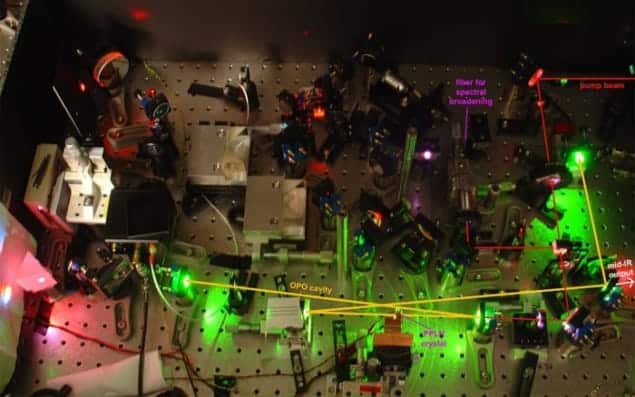
Scientists in the US have used an optical-frequency comb – a laser that emits light at a range of equally spaced frequencies, like the teeth on a comb – to monitor how well a device designed to kill dangerous bacteria does its job. The comb was used to measure the concentrations of ozone, hydrogen peroxide and other reactive molecules in the stream of air and cold plasma produced by the decontamination device. The study reveals that decontamination is most efficient when both a plasma and hydrogen peroxide are present in the stream.
“Cold-air plasmas” – room-temperature gases of ionized air molecules – are widely used to kill dangerous bacteria, both in medical and food-processing environments. While the technique is good at dealing with antibiotic- and heat-resistant bacteria, the devices can be even more potent if the plasma is combined with an antibacterial chemical such as hydrogen peroxide. But understanding why this process occurs and how it could be improved is not easy because accurately measuring the relative abundances of different molecules in the stream – and how they interact – is tricky.
Sensitive teeth
Mark Golkowski and colleagues at the University of Colorado, along with Jun Ye and team at JILA in nearby Boulder, have shown that an optical-frequency comb – a device normally associated with atomic clocks and precision spectroscopy – can get round this problem to study molecules in the decontaminating stream. When light from the comb passes through the stream, the presence of a specific molecule or ion is signified by the absorption of a specific set of teeth. According to Golkowski, JILA’s frequency comb offers the “unique capability of an extremely sensitive measurement and one that also yields information about the interaction dynamics, since many molecules can be simultaneously observed on short timescales”.
As well as quantifying how much hydrogen peroxide is in the stream, the frequency comb also revealed that the addition of hydrogen peroxide did not affect the level of the toxic gas nitrogen dioxide in the stream. The team also found that the levels of ozone and nitrous oxide in the stream halved when hydrogen peroxide was introduced. According to the researchers it is difficult to predict the relative concentrations of these molecules using numerical modelling, and therefore the frequency comb has given them a unique insight into the chemistry of their stream.
The research also confirmed that a hydrogen-peroxide-rich stream can quickly kill bacteria up to 3 m from the source. The system proved very effective at disinfecting surfaces of potentially dangerous organisms including Staphylococcus aureus – a cause of pneumonia and other diseases – and Pseudomonas aeruginosa, which is often found on medical equipment.
The research will be published in IEEE Transactions on Plasma Science.



